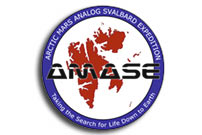NASA Arctic Mars Analog Svalbard Expedition Field Report (AMASE 2007): Winds and Changes

08.21.07
I awoke this morning at five am to find myself swaying in my bed. Sometime during the night the wind had picked up dramatically and large waves had developed where we were anchored near shore. For a brief while I thought we had started sailing a day early, but the shore remained fixed through the small porthole in my cabin.
During our morning meeting, we discovered that the waves were too big for us to safely take the Zodiacs to shore. We discussed leaving for our next site early, but the equipment in the lab needs to be tied down before we go and many of us are too nauseous to do much at the moment. The management team has decided we should stay put for a while, people can wait for the motion sickness medicine to kick in then we’ll meet up after lunch to reassess the situation.
Its 3pm and we’ve decided to continue hanging out in the same place. The ship has drifted a bit down the shore. Everyone is inside, huddled in various lab spaces catching up on work. The most exciting event was a near miss with a giant iceberg an hour ago. Or so we thought.
We heard strange loud noises coming from the ship so Oliver and I ran out on the deck to check it out. There was huge iceberg just off the bow. It looked like Lance was trying to rotate and get away from the iceberg, but every now and then we would suddenly get close again. We discovered that the Raman team had actually asked how close we could get to an iceberg so they could attempt to measure it with their laser from the ship’s deck. The idea sounded pretty crazy, but it would be so cool if it worked! In the end, they were unable to make their attempt because the ship was bouncing too much in the waves for the instrument to sit safely on deck.
At 5:30pm I exited my cabin for dinner and found the boat deserted. While I had been inside, Lance had sailed into a calmer bay and everyone had gone on shore for a walk around! Somehow I had missed the call and never realized that everyone had left! I was pretty bummed to not be on shore as the evening had brought blue skies and bright sunshine. To cheer myself up, I spent some quality time reading a Norwegian fishing magazine with Morton up in the bridge. The view from the panoramic windows of the bridge was spectacular and much warmer than from on deck. I watched the folks onshore through binoculars and joined them for dinner when they returned. It sounds like it will be a neat new Wahlenberg Fjord field site next year.
Kirsten Fristad
NASA Goddard Space Flight Center
About Kirsten Fristad in her own words…
Kirsten Fristad here again. I’m privileged and excited to be back writing Notes from the Field on AMASE 07. I am a planetary scientist working in the Sample Analysis on Mars (SAM) Lab at the Goddard Space Flight Center in Greenbelt, Maryland where I have been for the last year and a half. I graduated from Macalester College in 2005 with a major in geology and core in astronomy knowing I wanted to pursue a research career in planetary science. Through summer internships with several planetary scientists, I developed a background in analyzing martian and lunar planetary remote sensing data and Mars analog field work in Alaska. Over the last year I have continued to organize the Goddard/SAM Team contribution to AMASE, conducted organic analyses of AMASE samples, designed and built new field hardware and participated in two other expeditions in Utah and the Mojave.
Following AMASE 07, I will be staying on in Norway as a Fulbright Scholar to begin graduate work at the University of Oslo. I am very much looking forward to exploring more of this beautiful country, reconnecting with the country of my ancestors and filling up on pickled herring and lefse!








